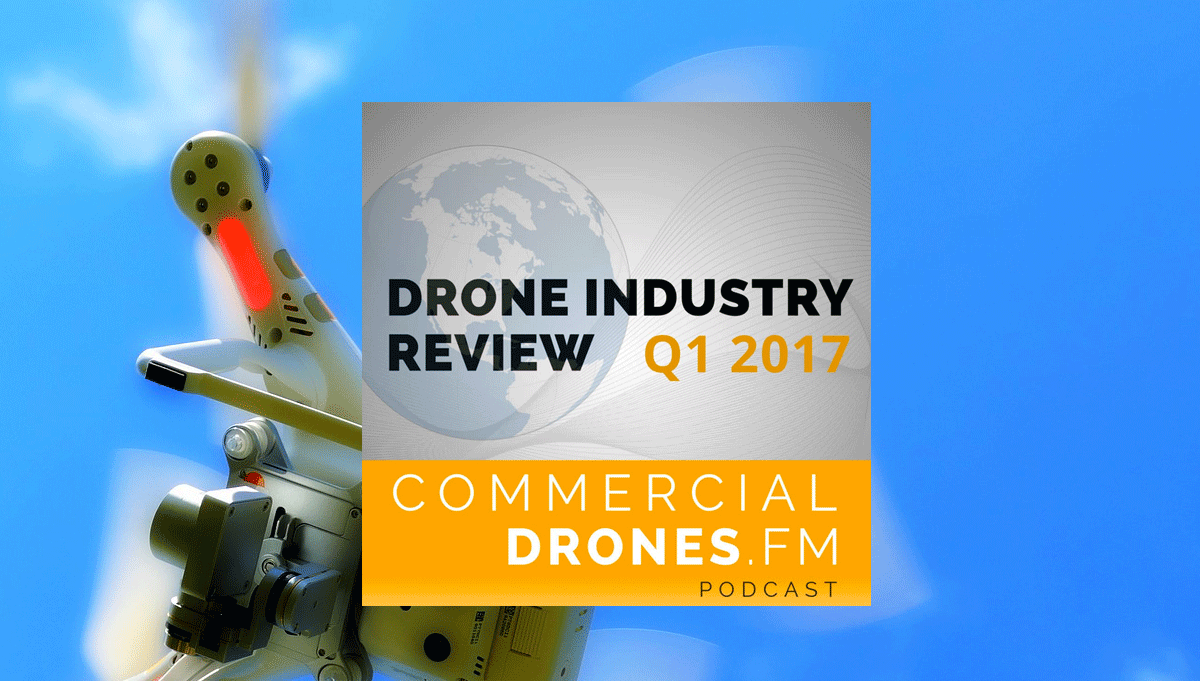Trying to keep track of everything that’s happening in the drone space is practically a full time job. Technology developments and changes to regulation are enough to keep up with on their own, but the various ways in which professionals of all types and sizes are looking at adoption means there’s that much more to assess and consider. It’s as important as it is difficult to try to stay up-to-date with it all.
On episode #42 of the Commercial Drones FM podcast, Drone Industry Review: Q1 2017, host Ian Smith does what he can to ease that burden when it comes to what happened in the industry so far in 2017. He runs through 15 topics in 20 minutes, which is about as concise as you can get when you’re talking through everything from software developments to delivery drones to how professionals in industries like mining and utilities are using these tools.I’ve been able to connect with Ian for a few additional insights around various episodes of his podcast, but between what he talked through and wrote up on his site, he’s already shared plenty. If you haven’t had a chance to listen to the episode yet, it’s available below. What follows is a few additional thoughts focused on some of the items that were discussed on the show.- Arguably the biggest piece of news on the hardware front this year was DJI’s announcement of the M200, which is a drone they’ve built specifically to be an enterprise solution. Echoing a theme that's come up in various contexts for multiple users, the fact that DJI is just as focused on how users can utilize the data they’re gathering from this drone as they are with the hardware is critical. It goes back to the concept of a holistic solution that enterprise users can properly leverage, regardless of the details associated with that process.
- Sensor capabilities are advancing by the day, and it’s incredible to think they’re still in their infancy. Thermal, multispectral and hyperspectral sensors are opening up new opportunities, and companies like FLIR are leading that charge as they work to drive down the size, weight, power and cost of thermal imaging.
- Larger-sized devices from RIEGL need to be utilized in the proper setting to create a worthwhile value proposition, but the opportunity they represent is real. These tools can be used to effectively perform aerial surveys of infrastructure and complex urban environments.
- Parrot’s pivot to the commercial drone industry, the failure of Lily Robotics and the acquisition of Skyward by Verizon are all major developments, and they all happened within the first couple months of the year. The shakeups we’ve seen so far in 2017 are fairly significant and could be very indicative of what else we’re going to see this year and beyond.
- It hasn’t been that long since Colin Guinn founded Hangar, and his inclusion in the DJI/GoPro story was a reminder of what a significant role he’s played in the history of this industry. What does Hangar have in store for 2017?
- Many were happy to see the definition that Part 107 brought to the industry, but the ability to operate BVLOS and fly at night are the sorts of operations that professionals are still looking to see rolled out. What it means to enact sensible regulation on a federal and local level is still an open question.
- News of Caterpillar and Airware teaming up to help construction, mining and quarrying organizations utilize drones along with the strategic alliance between John Deere and Kespry is a great illustration of how and where professionals are going to have the best opportunity to get their hands on drones. Perhaps more importantly, these agreements will enable users to talk with fellow professionals in specific terms around the impact of the technology.
- The “drone in the box” from Airobotics is absolutely one of the most innovative and practical uses of the technology out there, and their work to define what it means to operate BVLOS is a great indication of where they’re headed in a figurative and literal sense.
- Updates around how professionals in specific industries are difficult to even partially explore in a review like this, but the ways in which drones are being used in construction and agriculture are becoming more refined by the day. Elsewhere, the way in which drones will impact the future of the telecommunications industry is incredibly important to recognize.
"This is the future, here, in my opinion." - @TheChadColby #DDWebinar pic.twitter.com/EbGNukegym
— DroneDeploy (@DroneDeploy) April 26, 2017
- Speaking of the agriculture industry, proof of how quickly things happen and develop was on full display for this industry as DroneDeploy just announced an experimental new tool designed to create a map as your drone flies so you can take action before it lands. Chad Colby has already commented about how he sees this technology changing things for the better, and it’s the type of development that proves how fast things move in this space.
















Comments